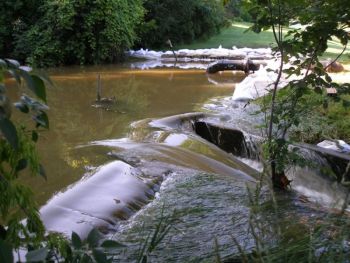Hydrology: Difference between revisions
No edit summary |
Rmanwaring (talk | contribs) No edit summary |
||
| Line 9: | Line 9: | ||
<!-- Delete any sections that are not necessary to your topic. Add pictures/sections as needed --> | <!-- Delete any sections that are not necessary to your topic. Add pictures/sections as needed --> | ||
Hydrology is essential not only in the design of a dam, but also in the feasibility study of a dam | Hydrology is essential not only in the design of a dam, but also in the feasibility study of a dam as well as in assessments of the dam into the future as the state-of-the-practice evolves. The three main components of [[Flood Hydrology|flood hydrology]], according to the United States [[Bureau of Reclamation]] (USBR) are “(1) hydrometeorology related to probable maximum [[precipitation]] determinations, (2) probable maximum flood hydrograph determinations, and (3) statistics and probabilities relating to the magnitude and frequency of flood flows”.<ref name="FHM">[[Flood Hydrology Manual | Flood Hydrology Manual, USBR, 1989]]</ref> | ||
“One of the most common causes of dam failures is the inability to safely pass flood flows. Failures caused by hydrologic conditions can range from sudden failure, with complete breaching or collapse of the dam, to gradual failure, with progressive erosion and partial breaching”.<ref name="FEMA94">[[Selecting and Accommodating Inflow Design Floods for Dams (FEMA P-94) | FEMA P-94 Federal Guidelines for Dam Safety: Selecting and Accommodating Inflow Design Floods for Dams, FEMA, 2013]]</ref> Therefore, hydrologic studies are among the most important sources of information when it comes to dam safety. | “One of the most common causes of dam failures is the inability to safely pass flood flows. Failures caused by hydrologic conditions can range from sudden failure, with complete breaching or collapse of the dam, to gradual failure, with progressive erosion and partial breaching”.<ref name="FEMA94">[[Selecting and Accommodating Inflow Design Floods for Dams (FEMA P-94) | FEMA P-94 Federal Guidelines for Dam Safety: Selecting and Accommodating Inflow Design Floods for Dams, FEMA, 2013]]</ref> Therefore, hydrologic studies are among the most important sources of information when it comes to dam safety. | ||
Revision as of 19:44, 19 December 2022

|
| All dams need adequate spillway capacity. Learn more at DamFailures.org |
Hydrology is essential not only in the design of a dam, but also in the feasibility study of a dam as well as in assessments of the dam into the future as the state-of-the-practice evolves. The three main components of flood hydrology, according to the United States Bureau of Reclamation (USBR) are “(1) hydrometeorology related to probable maximum precipitation determinations, (2) probable maximum flood hydrograph determinations, and (3) statistics and probabilities relating to the magnitude and frequency of flood flows”.[1]
“One of the most common causes of dam failures is the inability to safely pass flood flows. Failures caused by hydrologic conditions can range from sudden failure, with complete breaching or collapse of the dam, to gradual failure, with progressive erosion and partial breaching”.[2] Therefore, hydrologic studies are among the most important sources of information when it comes to dam safety.
Hydrologic Design Criteria
“Selection of an Inflow Design Flood (IDF) for a new dam or a dam undergoing significant modifications should taken into account both current conditions and reasonably anticipated future development. Development within the upstream watershed can cause increased runoff and peak flows, while development within the downstream inundation area can alter hazard potential classification and specific estimates of consequences of hydrologic events… When the cost of more detailed methods such as incremental consequence analysis, a site-specific probable maximum precipitation study, or risk-informed hydrologic hazard analysis is prohibitive, prescriptive IDF criteria for High, Significant, and Low Hazard dams are recommended”.[2]
Types of Evaluations
- Low Flow Conditions
- Normal Flow Conditions
- Flood Conditions
- Sedimentation
- Groundwater
- Unusual or Changing Conditions in a Watershed
Examples
Best Practices Resources
![]() Selecting and Accommodating Inflow Design Floods for Dams (Federal Emergency Management Agency)
Selecting and Accommodating Inflow Design Floods for Dams (Federal Emergency Management Agency)
![]() Technical Release 210-60: Earth Dams and Reservoirs (Natural Resources Conservation Service)
Technical Release 210-60: Earth Dams and Reservoirs (Natural Resources Conservation Service)
![]() Flood Hydrology Manual (Bureau of Reclamation)
Flood Hydrology Manual (Bureau of Reclamation)
![]() Hydrologic Engineering Requirements for Reservoirs (EM 1110-2-1420) (U.S. Army Corps of Engineers)
Hydrologic Engineering Requirements for Reservoirs (EM 1110-2-1420) (U.S. Army Corps of Engineers)
Trainings
![]() On-Demand Webinar: Hydrology 101 for Dam Safety
On-Demand Webinar: Hydrology 101 for Dam Safety
![]() On-Demand Webinar: Hydrology 201 for Dam Safety
On-Demand Webinar: Hydrology 201 for Dam Safety
Citations:
Revision ID: 5987
Revision Date: 12/19/2022
